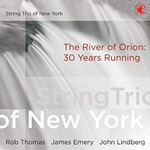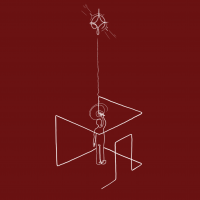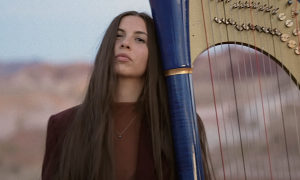Home » Jazz Articles » Interview » Lola Danza: Free To Sing Free
Lola Danza: Free To Sing Free
There's not a lot that has been explored as far as the palate of different sounds go, because there is such a vast range of sounds that you can make with the voice.
 Free jazz has wound its way through many permutations since arriving in the early '60s. An important custodian of its new directions is vocalist and composer Lola Danza, of Brooklyn.
Free jazz has wound its way through many permutations since arriving in the early '60s. An important custodian of its new directions is vocalist and composer Lola Danza, of Brooklyn.
Danza is a graduate of Berklee College of Music, Boston, and stayed in Boston for a few years after graduating, developing her approach to music before becoming completely "free" over the last three years.
Her latest album, Live Free (Evolver, 2009), is a live recording from a gig at Boston's Ryles Jazz club in 2008.
The instrumentation for the recording is voice (Danza, of course), tenor sax, bass and drums. The effect is inspiring, and the journey the listener is taken on in each of the three tracks is a true adventure.
Danza's voice has a range of four octaves, which she fully uses in each performance. Notes turn into low moans or emotional cries. On the album's first track, the music builds to Danza providing urgent high notes, followed by similarly frantic-sounding drums from drummer Bob Moses. The effect can appear ceremonial, or exploring.
"RaKaLam Bob Moses, he's legendary," notes Danza. "I'm very fortunate that we've played together so much."
The second track sees Danza "playing" (she sees the voice as an instrument, whether soloing or accompanying) a striking, climbing chromatic passage, followed by Moses playing an almost rock-like backbeat pattern.
Dynamic shifts are a strong feature of the music over the entire album, periods of quiet succeeding dramatic action. The saxophonist, Matt Langley, is brilliant on the record, at times recalling the sound of great swing and bebop sax players and at other times evoking modern free players like Ornette Coleman. Every note feels authentic. Langley's interplay with Danza is exciting to listen to. For example, in the third piece where the sax inverts the usual position of a voice (above the horn) by playing a very high note against Danza's low note. Near the end of the piece, their positions are reversed, with Danza high above Langley in a dramatic dissonance; shades of the ending of Charles Ives' second symphony.
The bassist is Wes Brown, and he too has interesting moments of interplay with Langley.
And it is all improvised, free, from start to finish. There is at times a journey-like drama: the mid-point of track three, for example, sees the musicians falling quiet briefly, before the adventure continues. Yet the structure was unplanned.
"That was totally improvised," she says. "There was no structural idea whatsoever. I don't really think in terms of preplanning a composition or form because I think that it can inhibit the player, so for me, I want to allow the players to be completely free to be themselves.
"So the important formula for what I do is choosing the right player. Choosing the players is essential. So I go around, I listen to players, I hear what they're doing and if I like what a player is doing and I feel he would work well with me—usually it's an intuitive thing. I look at them, I hear them and I say, 'That's the guy. I have to play with that particular player.' ... and [then] I put these guys together. I start hearing different guys and I say, 'You know what? This guy is going to work great with that guy, and with me.' I can hear what they're doing, and usually these players have really, really, really strong personalities. They really know who they are musically."
How did Danza find the musicians for the recording? The process, as she describes it, shows that the effective composition of the music begins before the actual gig. It begins with the choice of musicians who will be playing with her.
"This is going to really sound funny, but this particular recording, I played with these guys for the very first time. In fact, we had never played with each other except for Bob Moses and me. That night, originally I was supposed to have my bassist that I've worked with the most, John Lockwood, who is the bassist of The Fringe (Lockwood with George Garzone and Bob Gullotti). John played with Freddie Hubbard in his band and with Joe Henderson as well. I've had the pleasure of working with John for six years now.
"So that night was very interesting because John Lockwood couldn't make the gig and I had Moses on the gig, and I was supposed to have Jeff Galindo, this really great trombone player up in Boston that I've played with for the past four years. But he couldn't make the gig, so Jeff recommended Matt ... The other guy (on the gig) was Wes Brown, on bass. And Wes was recommended to me by RaKaLam Bob Moses. Wes played in Leo Smith's band, so it was really a treat to play with him. Such fabulous guys. I left Matt a message and I told him 'Hey, don't be afraid to blow. 'Cause the last thing I want is for a saxophonist or a horn player to be afraid to come in while I'm playing because I'm a singer, because I'm doing something and they don't want to step on my toes.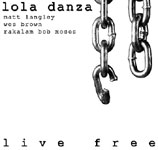 "So I told him, 'Don't be afraid to blow.' And then I left him this message saying 'You don't need to call me back. We don't need to discuss it. We don't need to talk about it. But know that my voice could be coming at you from underneath, above, sideways, inside of what you're playing. Just play.' So I left that message for him and I talked about the same sort of thing with Wes. ... He has this really awesome Bose equipment, a PA system, and he brought the Bose to the gig for me and I got to sing through that.
"So I told him, 'Don't be afraid to blow.' And then I left him this message saying 'You don't need to call me back. We don't need to discuss it. We don't need to talk about it. But know that my voice could be coming at you from underneath, above, sideways, inside of what you're playing. Just play.' So I left that message for him and I talked about the same sort of thing with Wes. ... He has this really awesome Bose equipment, a PA system, and he brought the Bose to the gig for me and I got to sing through that.
"I don't think in terms of 'Well this might sound good here. Let me try this there,'" says Danza about her music. "I don't think in those terms. Basically, I think what's happened is over the years of really practicing, ... my main thing, what I like to do at home is I practice a lot. You know, I've studied with so many people over the years, especially instrumentalists, which have been so important, as well as some really great vocal teachers. And through that process, that journey of really practicing and learning music, learning how to play the piano and really digging it, these things just sort of by osmosis, just sort of automatically come out in the music. Because you are practicing so many other things.
"And from practicing all those things, when you get musicians that are at this caliber, at such a high caliber, like RaKaLam and Matt Langley and Wes Brown, it's so easy. They put something out there and you respond off of what they're doing ... For me, when I'm listening to these players and being inside of the music, there are four individual and equal voices and I'm just speaking to these other players and they're speaking to me and we're responding and not responding off of each other."
She says she doesn't think in terms of changing keys.
"This music, it transcends paper. It's not about that. I just like the different transitions. We're creating together. We're composing together in the moment. No one is thinking about what key to play in. It's another type of playing. It's another type of hearing."
And she doesn't give signals to her band mates.
"The signals that I give are with my voice, because they know how to hear ... There is a very important element of hearing in this type of music. Because I don't deal with pre-planned forms or compositions, it's all about hearing, so it's about hearing and accepting the player as they are. With these guys, I am not trying to tell them, 'Hey, play this for me so that I can hear this and do that.' I don't do that and I don't like that. They come in, they know that I'm hearing. I'm accepting their playing as it is. I'm not trying to hear something or make it into something else. I just allow those guys to play what they love to play and I'm hearing ... I choose these players because they're brilliant and sensitive and they understand music.
"It's about another way of hearing music. It's a different way of listening, so when I'm hearing this music, I just hear the notes, the sounds, and I accept the sounds as they are. Then when you can do that, then you start to hear in a whole different way and it opens up your hearing and you hear behind the note. Because there is a whole concept. Just like when you're speaking to someone, the way you speak to a person, you can hear. You don't even have to know the words they're saying. You can hear from the nuances within their voice. The sudden changes in pitch when they speak. You can hear certain sounds that go beyond verbalization. So you don't have to actually say it. It just comes out. So that's the same thing with this type of playing."
"It's intention or spirit. It's almost like a Zen Buddhism, a Taoist thing," she adds.
Chapter Index
Influences
Danza gets inspiration from philosophy or other such writings.
"I like to read Krishnamurti," she says. "He's a favorite of mine. [And] people's biographies. I am in the middle of reading Albert Einstein's biography. Fernando Pessoa's 'The Book of Disquiet' is my bible. I love Rainer Maria Rilke. I love 'Letters to a Young Poet.' It's about what it means to be an artist. For me, living that life daily, I think, makes this music. It brings out all those things. I also practice Chinese yoga with my bassist and yoga teacher John Voigt."
In terms of listening to avant-garde jazz, Danza likes Albert Ayler and Charles Gayle. Of Ayler, she says "I like a lot of his beliefs, his philosophy. I really love and admire him and the freedom in his music. There's something there. It's spiritual. Just like John Coltrane. For me, Crescent (Impulse!, 1964), Sun Ship (Impulse!, 1965) and Ascension (Impulse!, 1965), those are my favorite Trane albums. There's this complete beauty in them and spirituality that goes beyond words.
"I love free jazz, avant-garde. But then, also, I like straight-ahead jazz too. I'll sing standards and solo over changes. I love listening to Sarah Vaughan and Anita O'Day ... I listen to so many different types of music I don't really like to say 'this is good music and that is bad. If it's good music, it's good music. Doesn't matter what genre. I love world music as well. And I have written some compositions where I get into flamenco and Asian influences."
Through drummer Moses and also her time at Berklee, there is inspiration from vocalist and scat-meister Sheila Jordan.
"I never studied with Sheila. She did a clinic at Berklee when I was there and I got to sit in and she was just amazing. I called her a couple of times for advice. She's just a wonderful, wonderful human being and brilliant musician."
Danza says Jordan's classic album Portrait Of Sheila (Blue Note, 1963) is a special favorite of hers. "Then there's this really amazing album, I think its Steve Swallow's record, and it's called Home (ECM, 1980). Bob Moses is on it and Sheila's singing these poems by a friend of theirs and that's an amazing record."
On broader avant-garde music in general, says Danza, "I love John Cage and his philosophy on sound. He's such a beautiful man, always so happy and full of laughter. I love Stockhausen and the way he talks about sounds. He says, 'If sounds can heal, it can evolve humanity.'" For older classical music, "I love Stravinsky, Shostakovich ... I love Rachmaninoff ... I got to see an amazing Russian concert pianist here in New York at the Met Museum. When I was living in Boston, I saw the Boston Symphony as much as I could."
Her favorite opera singer is Maria Callas. "I like to go to the opera at the Met a lot too." But for Danza, less predictable sources of music are also always at hand.
"One thing that I really like is this CD box set of music called The World Museum and it's these guys who go around all over the world collecting samples of tribes and different exotic sounds. Even some guy who's selling newspapers in the street, but singing it. In a different language, it sounds like a symphony. It sounds gorgeous. So yeah, I love that kind of stuff. It's inspiring."
Danza also lists "post-modern pop" as an influence. "I think of Beck and Björk. Björk is definitely an influence of mine. I love Björk ... The two albums I have are Debut (Elektra, 1993) and Medulla (Atlantic, 1994). Medulla I really, really respect because it's all voice. I love the harmonies she's using with the choir. I like the sounds that she makes. And I think she has a really great vision. I also have the making of Medulla DVD. I used to watch that a lot to get ideas.
"And Debut [Björk's first solo album], I really like. She takes a standard, "Like Someone in Love," and sings it over a harp with some sound sampling. The sound samples actually tell a story underneath the harp accompaniment—a sort of sound sampling accompaniment to the music and herself—and that's brilliant. I mean that is gorgeous. I'm into harp and I'm into sound samples."
class="f-right">
Background
Danza came from Boston to New York in 2007 to become more involved in free jazz. Guitarist Ben Monder, not a "free jazz" musician, was one of the musicians she sought out. "I did move here because of him and I had to play with him," she says. "And I've played with him a few times. I heard him and Theo Bleckmann [the expansive German singer and composer], and through Theo, I learned about (vocal innovator and composer) Meredith Monk. My godmother, opera singer Angie Perez, worked with Meredith in the '80s in Berlin. But I moved here for [Monder's] playing and the idea of a different kind of music existing for the voice in a whole new way. These guys like Ben, Theo, and Meredith are performing and writing revolutionary music for the voice, so I knew I had to be here in Mecca, New York City."
She has played with Monder at the Cornelia Street Café in New York. "Monder's played on my compositions. We did a little free thing and we did some standards, and he was incredible on my compositions. He's amazing, really amazing."
From the purely free-jazz aspect, Danza says she moved to New York because of Ornette Coleman. "He was the main guy." She also cites Anthony Braxton, John Zorn and her teacher, Jeanie Lovetri, as big draws to New York for her.
Before she lived in Boston, Danza's father was in the military band and the family moved around a lot, "So I don't really have any place where I'm from." She went to Boston to attend the Berklee College of Music and stayed. Currently, she attends the Aaron Copland School of Music at the City University of New York in CUNY Queens.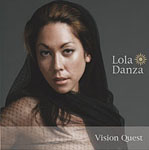 She's working on a master's degree in jazz performance and says the school's jazz department "has changed my life. The program is outstanding and the teachers are dedicated ... they love jazz and they love young musicians. They support the jazz scene. I believe it is by far one of the best programs in the country."
She's working on a master's degree in jazz performance and says the school's jazz department "has changed my life. The program is outstanding and the teachers are dedicated ... they love jazz and they love young musicians. They support the jazz scene. I believe it is by far one of the best programs in the country."
Danza's father is a jazz guitarist and her grandfather played jazz piano, but she didn't listen much to jazz music growing up. "I listened to classical music ... When I was 11, I had an LP of Beethoven sonatas and I listened to that record on repeat for years. I also remember, as a little girl, going to the record store to get an LP of Cindy Lauper, She's So Unusual (Portrait, 1983). "Time After Time" is a great tune on that album. Not to mention, Cindy Lauper looked really cool and pretty in her tutu on the cover. Then, after that, I started taking classical voice lessons and listened to Beverly Sills, Joan Sutherland, Frederica Von Stade, Kathleen Battle, Angie Perez, Maria Callas. I wanted to be an opera singer and sing Mozart's 'Magic Flute'—you know, be the Queen of the Night."
class="f-right">
The Voice as an Instrument
Other influences on Danza include Sarah Vaughan, Anita O'Day, Aretha Franklin, Jeanne Lee, and Nina Simone.
"Jeanne Lee is an avant-garde jazz singer, really incredible. And she's one of my favorites. She has a great album called Conspiracy (Earthforms, 1974) and there's another one with her and Ran Blake, a pianist. Really great."
She also acknowledged that at times on the new album she "does get into some tribal influence. I feel like the voice is a very flexible instrument. It's mind boggling. There's not a lot that has been explored as far as the palate of different sounds go, because there is such a vast palate of sounds that you can make with the voice. And if you look back through history, talking about tribal things around the world, with the voice 55 muscles are involved in making vocal sound. If you talk to any linguistic specialist, they'll tell you that when you are young you get used to using certain muscle positions that then affect the voice. And that creates an accent so you have a certain style of talking, because you are around certain areas or groups or whatever. So a French person sounds very different from an Asian person or an African person or an American person. Because we're using different muscle patterns and have different sized vocal mechanisms to create these sounds.
"What I think can happen through this type of music is the exploration of using different sounds with the voice to create. Because if you think about it, if you listen to a piano it has a certain type of sound. A saxophone has a certain type of sound. For instance, at a recent benefit concert that featured John Zorn, there was a pianist in his trio, Sylvie Courvoisier, who used mallets and duct tape on the strings of the piano to transcend the instrument. Hal Crook does it with his Harmonizer on the trombone. As an artist you try to transcend your instrument.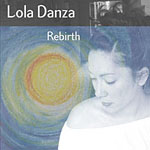 "Piano is a hard instrument to get different types of sounds out of it. If you look at someone like Lowell Davison or even someone like Cecil Taylor, they have been able to transcend the piano sound by having so much technique, so many different imaginative ideas, and the ability to create so much within the moment. At home, I'm practicing how to make these different types of sounds with the voice and put them into a musical context and just explore the flexibility. The possibility of using the voice within music is limitless."
"Piano is a hard instrument to get different types of sounds out of it. If you look at someone like Lowell Davison or even someone like Cecil Taylor, they have been able to transcend the piano sound by having so much technique, so many different imaginative ideas, and the ability to create so much within the moment. At home, I'm practicing how to make these different types of sounds with the voice and put them into a musical context and just explore the flexibility. The possibility of using the voice within music is limitless."
She says the voice "can be written into a symphony. For example, Berlioz: I love his 'Requiem.' He is actually having the choir comp for the (orchestra) in Latin. And it's a trip to listen to 'cause he's using the instrumentation in a totally different way. So when I heard that, I thought. 'That's another possibility.' So what I'm looking for are the possibilities and the impossibilities of what the voice can do.
"The human voice is limitless and has not been fully explored, not by any means. The human voice is capable of so many different things. And also for me, the human voice is really the connection, the essence of our being, of who we are, so in this music, that's what I'm doing. I am allowing that connection to be seen no matter how personal. It's who I am, and I am just allowing that to come out in this music."
class="f-right">
The Road To Avant-Garde
Before Danza's 2007 move to New York, she had not yet fully embraced free jazz: she says her compositions were world music with jazz. "It had form, but it was moving into the free thing. There would be free sections, and I was exploring and trying to go in another direction. So I wrote for a string quartet, and I use guitar, bass, and drums a lot and I have some albums that I released with that: Rebirth (Evolver Records, 2002) and Vision Quest (Evolver Records, 2005). In the last album, you can really see that there's a bridge between what just happened on this newest album and the singer-songwriter, jazz sort of thing.
Evolver is her own label.
Visionquest has a mix of free pieces as well as compositions. It's sort of chamber music-ish sounding, because I don't really use the drums very much and it (has) strings—it's two basses actually."
So what in particular led Danza to avant-garde?
"I think it's listening to instrumental music," she says, "and I wanted to be inside of the music and I think that free jazz allowed me to explore that without putting any limits on it, psychologically speaking. I started hanging out with these free jazz guys in Boston , Nat Magavero [drummer] and John Lockwood. The three of us sort of just having these experiments around Boston, and I just started playing with stuff, sitting in sessions, talking to people ... I had been searching. Looking back on this, I had been looking for this for a very long time, but did not know how to say what it was or what to call it. And somehow it found me.
"These last three years I've been working on what came out on that album. I'd been writing [and] singing compositions that I wrote, and I felt they were good but they weren't exactly what I was looking for, and I put strings on it to shake it up a bit ... But then me and some friends were listening to John Scofield, Steve Swallow and Bill Stewart in my apartment back in Boston years ago, and, as instrumentalists, they're able to experience music this way [by] being inside of the music. Instrumentalists can experience music in the way that a voice has not been able to experience in group playing. Usually the voice is on top.
"So this time I wanted to be inside of the music, just like a guitarist or a drummer, even more so than a horn because a horn stays on top a lot of times. I wanted to be inside, so that's the development of this process of learning how to be inside of the music. I wanted to actually have the voice comp for the band, have the voice give tones to support the band, rather than only singing on top of it. So that's what this project was about, and over the past three years that's what I've been investigating. It's been three years of working on this process of 'How can the voice do this?'"
She notes, "There is so much more territory that has yet to be explored. And right now, this recording, it's a year old and already I'm somewhere else, musically speaking. There's new territory. This music, it's changing. It grows so rapidly. You know, people are like, 'Are you going to do a CD release party and are you going to have the same band?' Well, you can't really have the same band because this recording, it's done. It's over. Now I am searching for more, the search for something else. This new album can never be captured again. That night doesn't exist anymore. It's in the past. I wouldn't want to relive it again. Not at all, because I'm thinking about something else now. I have so many ideas and I want to develop and explore them all."
"I have just discovered the music of Bill Laswell," says Danza. "Cause and Effect (Innerhythmic, 2007) and Imaginary Cuba (Wicklow/RCA, 1999) are extremely powerful, as they have a strong political message. Points of Order (Innerhythmic, 2001) is hip. Buckethead and Karl Berger are on it. Bill Laswell is masterful. He's brilliant."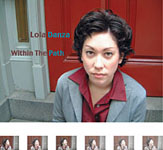
Guitarist Marc Ribot is also on her radar. "Saints (Atlantic/WEA, 2001) is a solo guitar record and he plays "Happiness Is a Warm Gun" from (The Beatles') White Album (Apple, 1968) and it's incredible. Ribot's interpretation of that tune is the sexiest thing I've heard in a long time. He's so amazing. He can totally manipulate the sound on his guitar. It's insane. He has many different personalities when he plays. It's as if each note takes on a life of its own. When he plays "Happiness Is a Warm Gun," he sounds like a cowboy. I mean it gets really dirty and it's groovin.' You feel it."
She adds, "I have a few guitar players I work with. I love guitar. I don't usually work with piano, just because I feel like guitar has so much more possibility because you can bend the note. A guitar can do anything. It has so much flexibility with pedals and all kinds of stuff. I love Bern Nix, Marc Ribot, Ben Monder, Bill Frisell, John Scofield, Egberto Gismonti and Dave Tronzo ... I just started playing with Bern Nix and he's legendary. He's got a solo album out called Low Barometer (Thompkinson Square, 2007). Bern is such a humble guy and a genius.
Dave Tronzo's a Boston guy now. He used to be in New York. Incredible, incredible. He plays slide guitar. There's a great recording of him live at the Knitting Factory playing "Monk's Dream" and it's amazing, beautiful, incredible. That, to me, is how Monk would have wanted it."
Of the trend of jazz artists making cover versions of rock tunes, Danza says, "It's great. I actually did that on my album Vision Quest. I used a Radiohead tune, "Motion Picture Soundtrack," and I also used Beck's tune."
It's interesting to note how she says "used." Jazz is all about improvising. She isn't saying she simply covered the tune. She took it as a start, and built on it. It brings to mind Bryan Ferry's talking of other people's tunes as "ready-mades." Even he, as a more traditional (though faintly avant-garde) rock singer, took songs written by other people and added his spin to them. Pre-written songs can be seen as "ready-made" to make a new start on—that is, beyond making a simple jazz band or group cover. And it is interesting that jazz artists such as Danza, Monder, Ribot, Herbie Hancock and the like are performing and recording their versions of some rock tunes.
It is perhaps not surprising that Danza was attracted to the music of Cindy Lauper when she was a child. Lauper's album contained, of course, "Time After Time," a hypnotic tune rapidly and successfully covered by Miles Davis.
class="f-right">
Nadu
But Danza doesn't stop at pure music. She has also been performing with an audio and visual concept group named "Nadu," which blends music with visual art—live music teaming up with live film, dancers and painters.
"Nadu's a different thing," says Danza. "It's my project that brings audio and visuals together. Nadu in Korean means 'me also.' That's exactly what I wanted to accomplish with this project—to bring a bunch of different 'me's,' different personalities, together to create an alter reality. I've been lucky enough to play at these spaces in New York that have allowed me to take Plexiglas and cover the stage with it, and then I have the painter come in and throw paint and paint to the music. I work with a lot of video artists to transform time and space, to go somewhere else. Where? I dunno. It's a work in progress."
She says the last project she did was at a gallery where "we covered all four walls with video and had the audience sit in the middle of the space and then the musicians were part of the video as well, while they were playing. There was a live-stream of video, and the artist triggered it with the sound. So he was creating the video as we were playing the music. He had patches of video and could trigger them while the sound was going. So if we started doing something crazy, he would trigger a certain type of footage to match or not."
In the true spirit of a free musician, Danza says she'll be "going where the music takes me, always changing, always going in different directions."
Selected Discography
Lola Danza, Live Free (Evolver Records, 2009)
Lola Danza, Vision Quest (Evolver Records, 2005)
Lola Danza, Rebirth (Evolver Records, 2002)
Lola Danza, Within The Past (Evolver Records, 2001)
Photo Credits
Top Photo: Duane Huang
Bottom Photo: Courtesy of Lola Danza and MGG Design
Tags
PREVIOUS / NEXT
Support All About Jazz
 All About Jazz has been a pillar of jazz since 1995, championing it as an art form and, more importantly, supporting the musicians who make it. Our enduring commitment has made "AAJ" one of the most culturally important websites of its kind, read by hundreds of thousands of fans, musicians and industry figures every month.
All About Jazz has been a pillar of jazz since 1995, championing it as an art form and, more importantly, supporting the musicians who make it. Our enduring commitment has made "AAJ" one of the most culturally important websites of its kind, read by hundreds of thousands of fans, musicians and industry figures every month.



